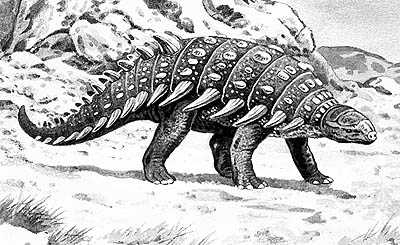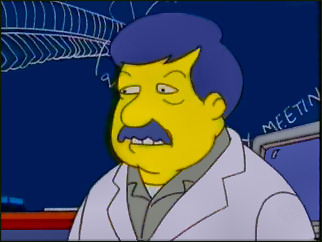Stegosaurus: Ornithischian Dinosaur, Late Jurassic
Ask anyone in the street to name three dinosaurs and they’ll probably give you Tyrannosaurus, Triceratops, then Stegosaurus. Stegosaurus is one of the most famous dinosaurs due to its instantly recognizable anatomy. The big lumbering body with a comically small head, the mountainous back with huge dorsal plates, and the long spikes jutting from its tail; yes, no other dinosaur, save other stegosaurians, fit this description. Stegosaurus was discovered by Othniel Charles Marsh during the Bone Wars in the latter part of the 1800’s. As such, it has had a rich history of scientific curiosity and pop culture influence.
Perhaps one of the more controversial aspects of Stegosaurus is the function of their dorsal plates. The first, and currently debunked, hypothesis was that the plates were used as defense. However, this is unlikely due to the relatively thin plates and how they only covered the back and not the more vulnerable sides. More likely were the two other hypotheses thermoregulation and display.
Stegosaurus could have used their plates for thermoregulation by rotating their bodies relative to the sun. Farlow et al. (1976) were among the first researchers to test this hypothesis by designing a Stegosaurus model and observing how well the plates could absorb or dissipate heat. Their results highly supported the hypothesis and they reasoned Stegosaurus could orient themselves relative to wind currents for better absorption or dissipation of heat. Main et al. (2005) disagree with the thermoregulation hypothesis as there is no proper blood circulation structure that could adequately carry and dispel heat away from the body. Also, other stegosaurians were more likely to have spikes than plates on their backs suggesting spikes were a basal trait that evolved later into plates. As such, thermoregulation, if it even played a role, was not the main function for the Stegosaurus’ plates.

From Walking with Dinosaurs Episode 2
Main et al. (2005) concluded that the plates were more likely used for both sexual and defensive display. Since dinosaurs had relatively good eyesight, the plates would have been highly useful for the aforementioned purposes. Indeed, Carpenter (1998) suggested that if attacked by a foe, the Stegosaurus would laterally display its body to appear more menacing. It would then pump blood into its plates to make them blush and appear frightening. This behavior is well reasoned due to the highly vascularized nature of the plates. Either way, it’s likely that the Stegosaurus employed both of these functions for its plates.

The tail spikes have a more humorous story to them. Though some scientists simply call them “the tail spikes” others took on the more informal name of “thagomizer” which was based off of the Far Side cartoon as seen above. Indeed, there’s really nothing else like the thagomizer and I just think the name fits. Regardless of what you call them, there was some debate on whether the thagomizer was really used for attacking purposes or not. Solid evidence came through in McWhinney (good lord, that’s his name?) et al. (2001) and Carpenter et al. (2005) papers. McWhinney et al., (2001) analyzed many Stegosaurian spikes and found that some of them had trauma-induced bone fractures and were healing or became diseased during their owner’s lifetime. Carpenter et al. (2005) analyzed a healed punctured wound in an Allosaurus tail vertebra and was able to match it with the tail spikes in Stegosaurus. Both of these evidence pieces support a willing intent for defense by Stegosaurus which in my book is pretty awesome.
Stegosaurus has shown up many many times in pop culture so I’ll try to keep the list down to the big ones. First off, this dinosaur has been seen in several movies, initially in King Kong and later in other big movies such as The Lost World: Jurassic Park, and The Land Before Time. It also starred in one of the most famous scenes in Fantasia; I especially remember this scene because the fight fit extraordinarily well with Stravinsky’s Rite of Spring with its loud, scary music and its build up to the climatic fight. Stegosaurus is also a favorite in many dinosaur documentaries such as Walking with Dinosaurs and When Dinosaurs Roamed America. Finally, and on a personal note, in the science fiction book Bones of the Earth, paleontologist and protagonist Richard Leyster was delivered a head of a Stegosaurus in the prologue so he could dissect it and be convinced that time travelling was real. I remember reading this book in Junior High and was convinced from that scene alone that if I wanted to be a good paleontologist, I better know my biology.

——
STEGHOST

Type: Ghost
Stats: HP: 120, Attack: 105, Defense: 70, Special Attack: 68, Special Defense: 83, Speed: 49
Ability: Intimidate, Solar Power, Hidden Ability: Sap Sipper
Moves Learned Upon Leveling Up:
Start-Lick
Start-Tail Whip
7-Mean Look
11-Yawn
16-Astonish
20-Iron Tail
24-Swords Dance
29-Spikes, Toxic Spikes
35-Poison Tail
42-Amnesia
49-Belch
55-Synthesis
60-Thagomize
Learnable TMs and HMs Calm Mind, Roar, Toxic, Bulk Up, Venoshock, Hidden Power, Sunny Day, Taunt, Ice Beam, Blizzard, Hyper Beam, Light Screen, Protect, Rain Dance, Safeguard, Frustration, Solar Beam, Thunderbolt, Thunder, Earthquake, Return, Shadow Ball, Double Team, Sludge Bomb, Reflect, Sludge Wave, Flamethrower, Sludge Bomb, Fire Blast, Torment, Façade, Rest, Attract, Thief, Low Sweep, Energy Ball, False Swipe, Fling, Quash, Will-O-Wisp, Shadow Claw, Payback, Swords Dance, Psych Up, Dragon Tail, Poison Jab, Sleep Talk, Substitute, Nature Power, Dark Pulse, Strength
Special Moves: Thagomize: Ghost Type, Power: 90, PP: 15, Accuracy: 100%. The user builds up antimatter on its thagomizer and then attacks the foe with it. 10% chance of poisoning the foe.
Egg Group: Monster
Pokedex Description Version One: When frightened, a Steghost’s body will disappear leaving only its plates visible to confuse and scare off its foe.
Pokedex Description Version Two: A Steghost’s thagomizer can kill an attacking foe with one mighty swipe. The victim can also be poisoned by it as well.
Evolution: Evolves from Kentrospirit at level 32.
Basic Background: I’ll be honest; I made Stegosaurus a ghost type because you could easily corrupt his name into Steghost. But this worked pretty well in my favor thanks to those scary plates of his! It’s also pretty liberating to not give Stegosaurus a typical type like Grass Type. With Ghost Type, you can explore different possibilities or ideas that other types couldn’t explore. Like antimatter! Since Giratina is antimatter I reasoned that other ghosts could also employ the antimatter so thus, Thagomize was created. I also realized that there wasn’t a strong Ghost Type move so Thagomize had a base power of 90 and is similar to Thunderbolt and Ice Beam.
Steghost uses aposematic coloration to confuse and frighten its enemies. The brightly shaded and contrasting plates draw the eye to them and mute the rest of the dull-colored body. These bright colors can warn predators not to mess with Steghost, especially how it can poison its enemies with its thagomizer.
Steghost was part of my story fairly early on and was one of the first members in the protagonist’s team. He caught him, in his first form as a Kentrospirit, in the Sprout Tower. The protagonist found him cowering near the top of the tower and managed to pick up the heavy beast in order to save him. When the ghosts surrounded them near the entrance of the tower, Kentrospirit found its courage and illuminated its spines and plates creating a frightful-looking monster. The Kentrospirit, and later Steghost, would become a steady member on the team ever since that experience.
Steghost was designed with a competitive use in mind. He could be staller with Intimidate and the use of Spikes, Toxic Spikes, Synthesis, Will-o-wisp, Amnesia, and Yawn. He could be a physical attacker with Grass Sipper and the use of his physical attacks and Swords Dance. Or he could be a special attacker in Sunny Teams with Solar Power and the use of Synthesis and special attack moves.
Carpenter, K., Chure, D., Kirkland, J. I., Denver Museum of Natural History, 1998. The Upper Jurassic Morrison Formation: an interdisciplinary study Part 2. Taylor & Francis. p. 137
Carpenter, K., Sanders, F., McWhinney, L. A., and Wood, L., 2005. Evidence for predator-prey relationships: Examples for Allosaurus and Stegosaurus. In Carpenter, Kenneth (ed.). The Carnivorous Dinosaurs. Bloomington and Indianapolis: Indiana University Press. p. 325.
Farlow, J.O., Thompson, C.V., Rosner, D.E., 1976. Plates of the dinosaur Stegosaurus: Forced convection heat loss fins? Science. 192: 1123–1125.
Main, R. P., Ricqles, A., Horner, J. R., and Padian, K., 2005. The evolution and function of thyreophoran dinosaur scutes: implications for plate function in stegosaurs. Paleobiology. 31:291-314.
McWhinney, L. A., Rothschild, B. M., and Carpenter, K., 2001. Posttraumatic Chronic Osteomyelitis in Stegosaurus dermal spikes. In Carpenter, Kenneth(ed). The Armored Dinosaurs. Indiana University Press. pp. 141–156





























